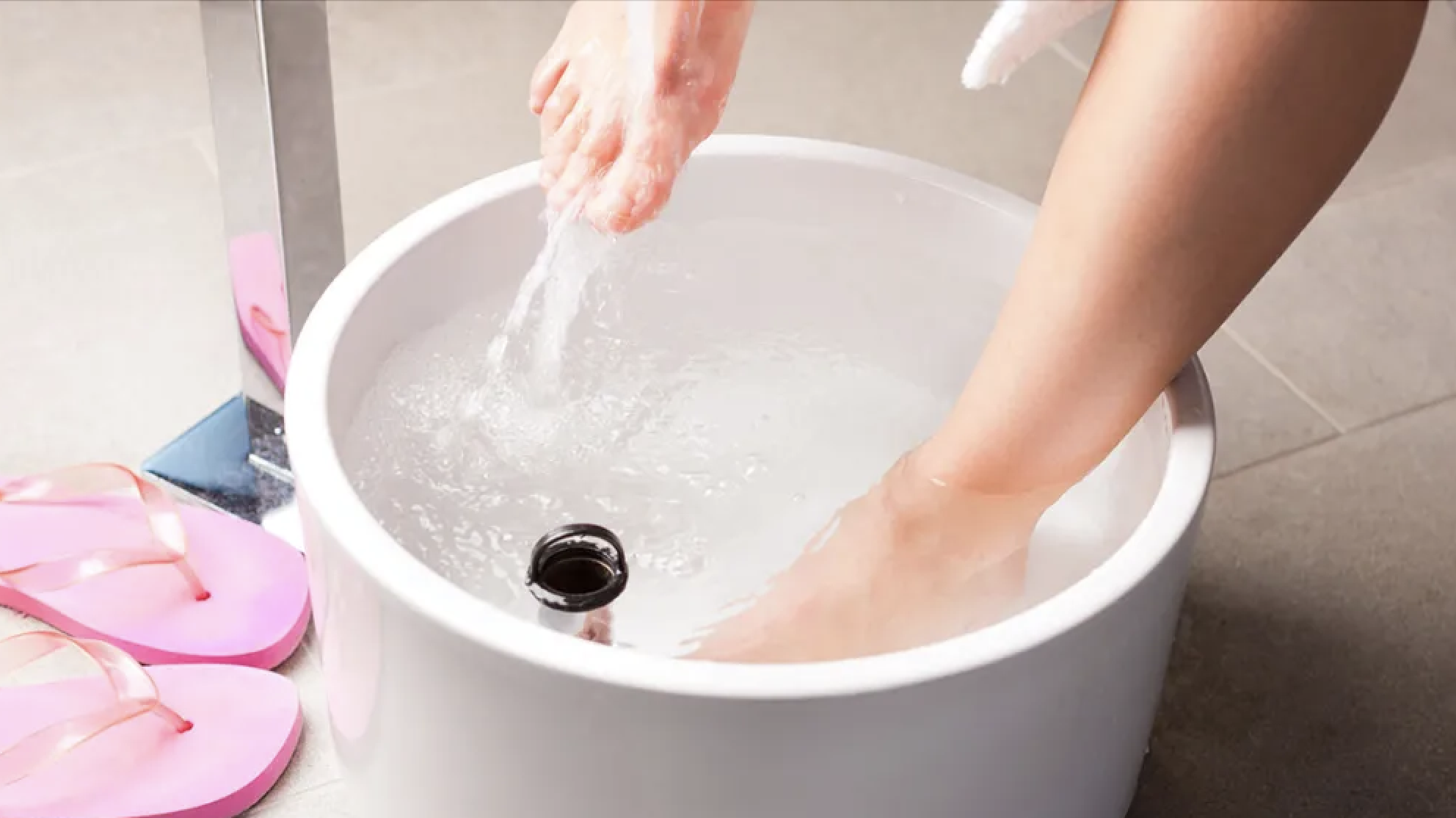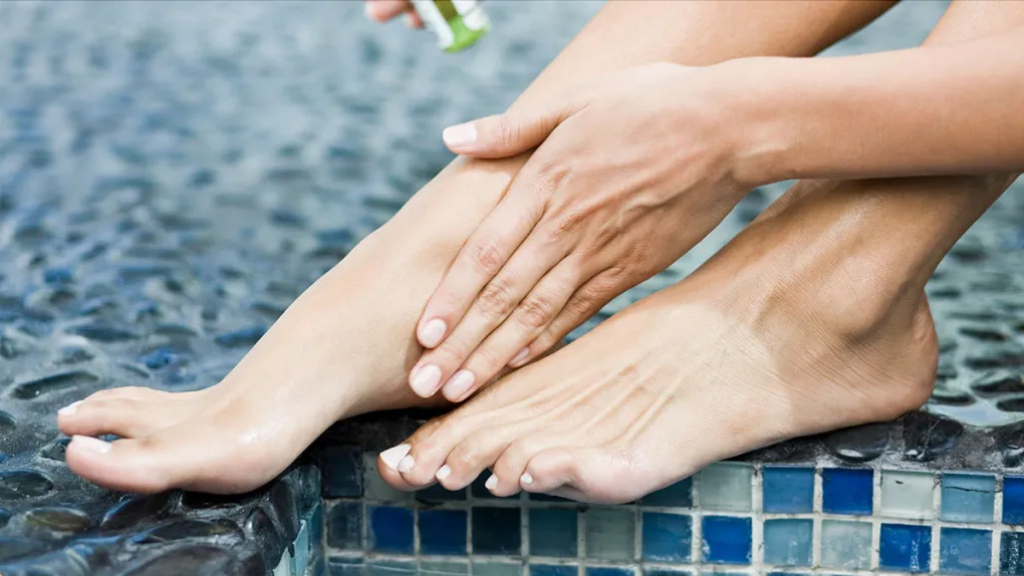The Best Way To Dodge Foot Pain From Standing All Day: Shift Your Weight *This* Way, Says Body Mechanics Pro
Plus, 7 other genius tips from MDs and specific shoe recommendations

If you’re a teacher, nurse, hairstylist or cashier, we don’t need to describe how much your feet can hurt after standing all day — you know all about the generalized foot pain, the swollen ankles, the sharp stabs of pain that can strike the ball of your foot. There’s also the tell-tale tightness in the arches and heel pain that can signal plantar fasciitis. And the discomfort can often extend upward leading to leg cramps and lower back pain. The good news? The doctors we spoke with assured us that just by making small tweaks to your routine, you can literally sidestep a lot of that pain. Here, podiatrists and other foot experts explain how to stop foot pain from standing all day.
Why does standing all day lead to foot pain?
Each of your feet has 26 bones and 33 joints that provide support and assist you with movement. These components are incredibly tough, but they’re susceptible to injury and overuse. Staying mobile can help slow this process, but standing still tends to speed it up.
“When you’re walking or running, part of your stride is actually spent with your foot off the floor, not bearing any weight at all,” explains Clifford Jeng, MD, FAAOS, Medical Director at The Institute for Foot and Ankle Reconstruction at Mercy Medical Center in Baltimore. “Standing in place puts continuous weight on your feet, albeit with less impact. Also, when you’re standing still it doesn’t mean your muscles are at rest. The muscles in your calves, ankles and feet are continuously working to balance your legs and keep you upright.”
Samantha Landau, DPM, MPH, a doctor of podiatry and instructor of orthopedics and pediatrics at the New York College of Podiatric Medicine in New York City, compares standing for long hours to tallying up the mileage on your car.
“As we age, we all add miles to the tires of our lower extremities, so to speak. Our ligaments tend to loosen and our foot mechanics aren’t as optimal as they once were.” As a result, the more you stand, the more likely you are to have foot pain.
How to stop foot pain from standing all day
There are plenty of strategies that can help keep your tootsies from aching, many of which are incredibly budget-friendly:
1. Lean back on your heels
Believe it or not, the way that you stand can help prevent foot pain before it starts. Biomechanist Katy Bowman, founder of the movement education company Nutritious Movement, says even though the biggest bones are at the back of the feet, most people tend to center their weight at the front, where there are smaller bones that are less capable of handling the load.
“Learning to back your hips up so they sit more over the back of your feet is helpful,” says Bowman, best-selling author of Simple Steps to Foot Pain Relief, who also recommends fidgeting. “Try shifting the weight from your right to left foot and from front to back and vice-versa while you’re standing in place. This prevents your feet from carrying the same load, so there’s less risk of a repetitive injury.”
2. Wear comfortable, supportive shoes
“Good shoes are everything,” says Dr. Jeng. “Your feet are the most constant points of contact with the world around you and therefore see the most impact and stress. Wearing well-cushioned, supportive shoes helps make that interaction more gentle and sustainable.”
What to look for in dress shoes: “[Try to find] flat shoes that have some cushion to them,” advises Bowman. “Heeled shoes push your weight onto the smaller bones of your feet. Shoes with a cushion reduce pressure on your foot bones and the nerves trapped between your body weight and the floor.”
Another feature to consider : wide toe boxes. “These provide room for your toes,” explains Bowman. “This gives you more surface area to spread a load over and it also allows you to wiggle your toes for exercise while standing.”
(Click through for the best dress shoes for plantar fasciitis and to learn how swapping heels for flats can ease foot pain and varicose veins.)
Doctors’ recommendations for sneakers: “In the over 20 years I have been taking care of peoples’ feet and recommending shoes, I have never seen such an overwhelmingly positive response as to the Hoka Bondi sneakers (Buy on Zappos, starting at $164.95),” says Dr. Jeng. “These shoes have an enormous amount of midsole cushioning and the shape of the outer sole encourages a healthy progression of the pressure under the foot that can prevent injury.” The Hoka Bondi line has such a stellar reputation that Dr. Jeng says that many other big-name shoe brands are now creating their own sneakers to mimic the design.
Still, that’s a pricy pair of shoes! If you’re looking for lower-priced options, Dr. Landau has some recommendations. “I like the Brooks Neutral running shoe (Buy on Amazon, starting at $69.95) for more active people and the ASICS Gel Venture (Buy on Amazon, starting at $64.95) or the New Balance 857 (Buy on Amazon, starting at $112.50) for those who are less active,” says Dr. Landau. “These shoes meet all of the qualities I require and fit orthoses (shoe inserts) as well.”
3. Add extra support with shoe inserts
Shoe inserts, like insoles and heel pads, take pressure off the painful areas in your feet and ankles. This makes them a great investment if you’ve been diagnosed with foot abnormalities, like bunions, hammertoe or a Morton’s neuroma (a nerve tumor that forms at the front of the foot, usually between the third and fourth toes). Inserts provide extra support and help keep your feet in the proper position. (Click through to see how inserts can also help with lower back pain when walking)
“A good option is to get Superfeet (Buy on Amazon, starting at $48.99) or similar over-the-counter insoles. Use them to replace the normal insoles that come with your shoes,” says Dr. Jeng. “These insoles conform more to the undersurface of your foot and therefore make more contact with the ground, enabling them to distribute the forces on your foot more evenly.” (Click through for the best insoles to ward off foot pain.)
Dr. Landau concurs, but says that custom orthotics are often more effective than those you can purchase at the pharmacy or drug store. Custom orthotics are prescribed by a foot doctor and are designed to support the unique shape and curvature of your feet. Insurance often covers the cost.
4. Establish a home foot care routine
After eight or more hours of standing, your feet deserve pampering. And, there’s no better way to do that than with some daily post-work foot care. Try the following self-care techniques:
Soak feet in an Epsom salt bath

Epsom salt has been used for hundreds of years to relieve muscle pain, stiffness and other musculoskeletal ailments. It’s rich in magnesium, which helps fight inflammation. To get the perks, simply add ¾ cup of Epsom salt to a bath or foot basin and mix until dissolved, then soak your feet for 20 to 30 minutes. Add a few drops of essential oil if desired — it’s been shown to ease pain by 58%. (Click through for more ways essential oils can heal body and mind.)
Try topical pain relievers
Topical pain relievers, like non-steroidal anti-inflammatory (NSAID) gels and sprays, are another effective way to relieve foot pain caused by standing. “Topical Voltaren Gel (Buy on Amazon, $18.48) or Salonpas with lidocaine (Buy on Amazon, $31.02 for a 3-pack) may be helpful for your pain,” says Dr. Jeng. Also worth trying: tiger balm, which decreases the sensation of pain.
“I like using an all-natural anti-inflammatory, like Arnica gel on the area,” explains Christi Slaven, a certified corrective posture therapist and the founder of Professor Posture. “This settles down the angry, overused muscles that are stressed and inflamed. Arnica helps those muscles open up and relax so it’s easier to stand.” One to try: Boiron Arnicare Gel (Buy on Amazon, $8.32).
Ease foot pain with a frozen water bottle
“Keeping a plastic water bottle frozen to roll out your feet at the end of the day is my favorite hack,” says Bowman. And for good reason! Ice helps numb the nerves in your feet, reducing pain and relieving inflammation.
Ice is especially beneficial if you suffer from plantar fasciitis, chronic heel pain caused by inflammation of the plantar fascia, a ligament that helps you walk and supports the arch of your foot. (Click through for the flip flops that healed one woman’s plantar fasciitis pain and to learn what to do if you have plantar fasciitis so bad you can’t walk.)
One study, published in the journal Physical Therapy Rehabilitation and Science found that plantar fasciitis patients who iced their feet before going to bed at night experienced a 44% reduction in pain. Tip: Before icing your feet, put on socks or wrap a washcloth around the frozen water bottle to prevent freezer burn.
Close out the day with a foot massage

Have you ever noticed that rubbing your feet at the end of a long day causes you to let out a sigh of relief? There’s a reason for that ahh feeling!
Targeted hand motions like kneading and rubbing stimulate your blood vessels and increase circulation to your feet. What’s more, they cause your brain to release endorphins — feel good chemicals that limit pain. Massage offers the added benefit of easing muscle tension. When the soft tissues that support your feet and ankles are loose and flexible, they’re less likely to tighten up and spasm.
The easy how-to: Sit on the floor or in a comfortable chair. Squeeze a dime-sized drop of arnica or another ointment on your palm and rub into your skin, taking time to massage the sole, heel and ball of your foot. Massage the top of your foot and toes as well. Gently spread your toes apart. Wiggle them back and forth and massage them individually. Lightly squeeze and move your thumb and finger upward, as if you’re squeezing toothpaste from a tube. Repeat the same steps on the other foot
Giving yourself a foot massage can be challenging if you have arthritis or another medical condition that affects the mobility of your hands. Luckily, there are various manual massage tools. Take the Tumaz Massage Ball & Foot Roller 3-in-1 set, for example (Buy on Amazon $20.95) which contains a spiky ball, a lacrosse ball, and a massage roller. K. McGuire, who bought the roller on Amazon, raves, “This foot roller is amazing! It worked so well that my arch pain diminished within two days of using it for about 10 min. twice a day!”
What to do if foot pain continues
Taking care of your feet can significantly reduce your risk of pain, but it isn’t necessarily a guarantee. According to Dr. Jeng, there’s a small subgroup of people who develop foot pain because of underlying medical problems, like bunions, bone spurs and ankle instability.
“These people should seek the advice of a doctor or orthopedic surgeon who specializes in the foot and ankle,” he says. After an evaluation and testing, your healthcare provider can make personalized treatment recommendations to relieve pain and help get you back on your feet.
This content is not a substitute for professional medical advice or diagnosis. Always consult your physician before pursuing any treatment plan.
Click through for more foot health news…
Plantar Wart Treatment At Home: MDs Reveal The 6 Most Effective Options
Good News: You Can Dodge The Top Cause of Foot Pain With This Simple Daily Routine












